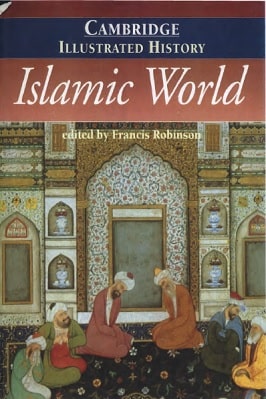
| Book Title | Cambridge Illustrated History Of The Islamic World |
| Book Author | Francis Robinson |
| Total Pages | 347 |
| Book Views | |
| Language | English |
| Book Download | PDF Direct Download Link |
| Get Hardcover | Click for Hard Similar Copy from Amazon |
Cambridge Illustrated History of the Islamic World by Francis Robinson
A Muslim and a Christian play the ud or lute together, from a thirteenth-century Booli of Chants in the Escorial Monastery of Madrid.
CAMBRIDGE ILLUSTRATED HISTORY OF THE ISLAMIC WORLD
Medieval Europe was deeply influenced by Arab-Islamic culture, transmitted particularly through Spain. In music, some of the many works in Arabic on musical theory were translated into Latin and Hebrew, but the main influence came from the actual arts of singing and playing spread by minstrels.
Amongst the living traditions thus influenced is that of the Morris or ‘Moorish’ dancers of England. Recent investigations in musical history have found pervasive Arab influences over the development of flamenco music, affecting everything from the style of performance to the rhythm and scales of the songs themselves.
For a moment it had been feared that the holy places of Islam, Mecca, and Medina, would fall into infidel’s hands. Muslims, who for centuries had walked hand in hand with power, had good reason to feel that history had deserted them.
The twentieth century has witnessed, from the emergence of modern Turkey in the early 1920s to that of the Muslim republics of the former Soviet Union· in the 1990s, steady decolonization of the Muslim world. But for many this has seemed a pyrrhic victory.
More often than not they have found western rule replaced by that of Muslims with western values, while western capital and western culture have come to be even more corrosive of their customs and their standards than before.
This challenge has elicited from Muslims throughout the world an assertion of an Islamic and for some a totalitarian Islamic, future for their people.
Such views have not been shared by all Muslims but have come to be shared by enough to represent a significant threat to the secular leaders of their societies, and on occasion, as in the revolution in Iran, to drive their upholders to power.
These Muslims, who are popularly known as ‘fundamentalist’ in the West but are more appropriately known as ‘Islamists’, are seen to challenge some of the most cherished principles of the contemporary West, whether it be the position of women, human rights, or the role of revealed religion in modern life.
Such is the fervor of the challenge and such is the violence with which some Islamists are prepared to press it forward, that there has been talking in the aftermath of the collapse of the Soviet Union of the red menace being replaced by a green one.
History can offer few answers to present problems, but it can place them in perspective and enrich understanding. Islamic history demands attention because o-f the numbers of humankind who claim that past for their own, because of the’
achievement of that past in the saga of human history, and because of the challenge which the inheritors of that past place before the present.
Western attitudes to Islam
Anyone setting out to explore Islamic history should first arm themselves with some knowledge of the hostility towards Islam which has infused western culture
over many centuries. Some Christians have felt bound to oppose a faith which1 denied the Christian doctrine of the Trinity, which denied Christ’s crucifixion, and which raised the authority of its Quran over that of the Bible.
Some Christian rulers, equally, have felt bound to oppose the armies of a faith which for nearly one thousand years from the Arab thrust to Poitiers in 732 to the Ottoman advance on Vienna in 1683 has threatened to penetrate to the heart of Christen-, dom.
Indeed, the Crusades from the eleventh to the thirteenth centuries, when Christian rulers took the fight against Islam into the eastern Mediterranean lands, was one of the great forces of European history.
It is hardly surprising, therefore, that from the early Middle Ages to the’ Enlightenment European attitudes to Islam were instinct with hostility.
Early European attitudes, which out of ignorance were fashioned from hearsay and fantasy, dismissed Islam as a Christian heresy and its Prophet as a sorcerer, whose success owed much to the divine imprimatur he gave to sexual license.
With the Crusades there came the first translations of the Quran into Latin and a more knowledgeable approach.
This was accompanied by a redoubled attack on the status of Muhammad as a prophet and assaults directed at those aspects of his message which seemed to condone the use of violence, to endorse sexual freedom in· this world, and to promise sexual ecstasy in the next.
These basic lines of attack were continued through the Renaissance and Reformation so that on the eve o the Enlightenment the widely accepted picture of Muhammad was of an impasto who had founded a heresy and given it the name of religion.
The eighteenth and nineteenth centuries saw a continuation of the old attack against Islam.
They were carried by missionaries who, taking advantage of the growing European ascendancy, now fanned out across Muslim lands; much of the medieval polemic, for instance, was repeated in a Life of Muhammad published 1851 by the Bombay Tract and Book Society.
But their message was broadcast, too, by westerners with purely secular concerns.
Such was the impact of the writer Flaubert and de Nerval, or the painters Ingres and Gerome, who associated sex,
To read more about the Cambridge Illustrated History Of The Islamic World book Click the download button below to get it for free
Report broken link
Support this Website
Click here to join our Telegram group for new Books